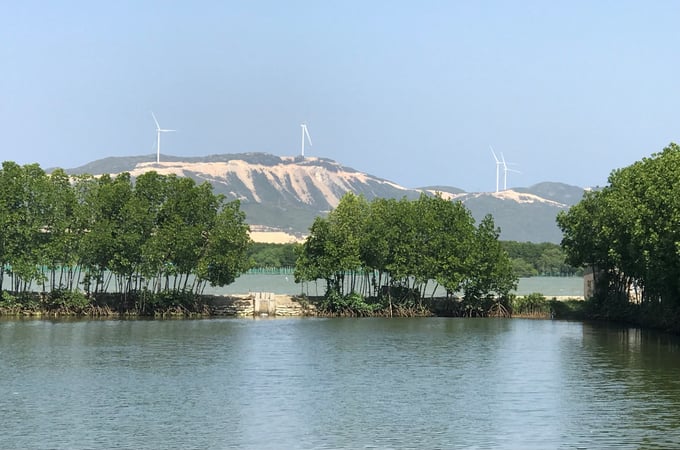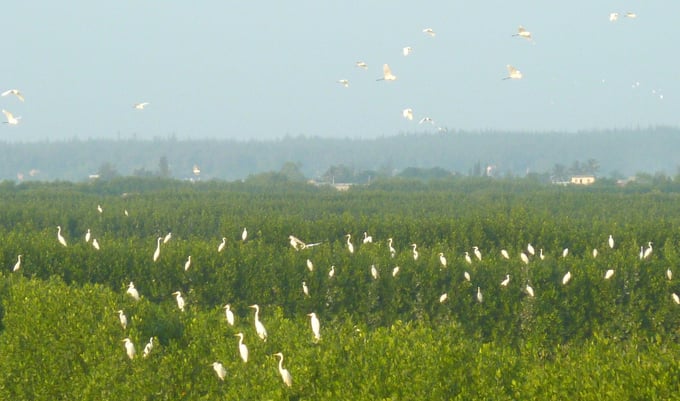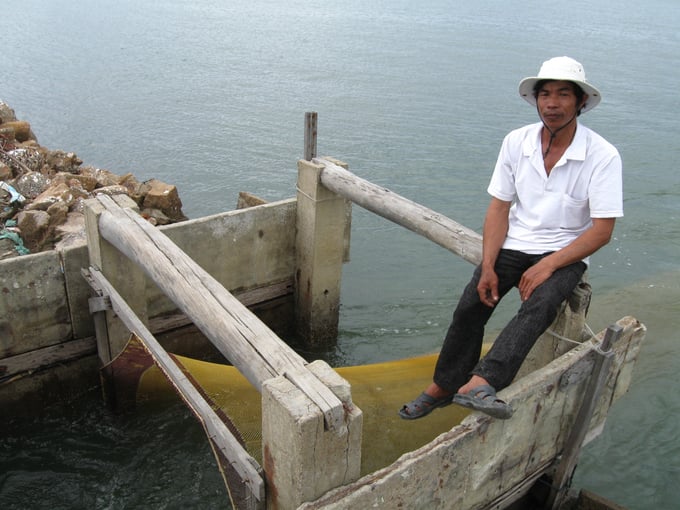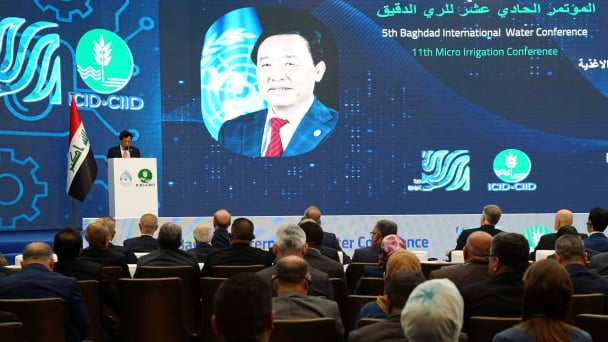May 29, 2025 | 09:27 GMT +7
May 29, 2025 | 09:27 GMT +7
Hotline: 0913.378.918
May 29, 2025 | 09:27 GMT +7
Hotline: 0913.378.918

The shrimp ponds are interwoven in the mangrove forest. The green color of the forest mixed with the blue of the sky and water is very attractive to tourists. Photo: V.D.T.
The ecological area of Con Chim - Thi Nai lagoon, located in Tuy Phuoc district (Binh Dinh) has now become a desirable tourist destination. The square shrimp ponds, with the green color of the mangrove forests, have led the birds to come here to live, especially in the late afternoon the storks gather in flocks, making Con Chim become an "ecological pearl island". No tourist wants to miss it whenever they can return to Binh Dinh.
According to Mr. Tran Van Thanh, Director of Binh Dinh Department of Culture, Sports and Tourism, Con Chim oasis has excellent potential for developing eco-tourism with the strength of its pristine river-like landscape in the Southwest region. Especially when the sunset falls, many birds fly here and create a peaceful space. The products here are also vibrant: Shrimps, crabs, and fish are reared in ponds. Suppose Con Chim is put into operation for tourism. In that case, it will be a good condition for Binh Dinh's tourism industry to have an attractive Green journey from a mangrove forest destination, and this service will improve the living standards of local people.
Tuy Phuoc District People's Committee has coordinated with Ton Duc Thang University (Ho Chi Minh City) to build a pilot model of homestay tourism here. The leaders and functional authorities of Tuy Phuoc district from the homestay tourism model to combine the most effective exploitation of the potential and advantages of the mangrove forest in association with aquaculture, create more livelihoods for people living in the river expectation areas, and realize the goal of tourism development of the local area step by step.
Shrimp farming areas by intercropping shrimp - crab - fish in Binh Dinh are all in river areas. In addition to areas covered with mangrove forests, ponds in the integrated aquaculture area also have mangrove trees. Around the pond, the space is covered with green trees, water, and sky.

Mangroves lure the birds of the sky to live. In the late afternoon, the storks gather in flocks, helping Con Chim become an "ecological pearl island". Photo: V.D.T.
The potential of eco-tourism and "green tourism" of the natural aquatic aquaculture areas in Binh Dinh is bright. However, to become a reality, the functional branches of this province still have a lot of things to do.
According to Master Ta Xuan Hoai, Ton Duc Thang University, the current problem of Binh Dinh is how to let tourists know about Con Chim so that visitors know that when coming here, they will live and breathe in the ecological environment with fresh air in a calm green space and a culinary experience. By all means, Binh Dinh must inform visitors that this place is a stopover with good service.
However, according to Dr. Nguyen Dinh Thanh, Head of Social Research Department (Institute for Socio-Economic Development Research of Binh Dinh Province), the current speed of urbanization in the lagoon areas has disrupted many spaces and greatly affected mangrove areas. In the long run, the authorities and functional sectors in Binh Dinh need to realize this problem and make reasonable calculations to avoid hurting the "lungs" of Binh Dinh's space, depriving many areas of the advantage. Residents can develop eco-tourism to avoid regret later.
The "choke point" in developing ecotourism in the integrated aquaculture areas in the mangrove forest of Binh Dinh is that the downstream environment is under serious threat from pollution originating from the upstream area. This pollution not only harms the aquaculture of the people here but also disrupts the ecological environment of the whole region.

For the past two years, the integrated aquaculture area under the dyke in Binh Dinh has often flooded the gate due to the influence of climate change. Photo: V.D.T.
The habit farmers in the upstream areas often throw agricultural waste into rivers and streams. The most worrying concern is the packaging of plant-protection drugs.
To overcome this situation, the natural resources and environment sectors, the agricultural sector, local authorities, and the people must work closely together to prevent it. Waste must be treated at the source to reduce pollution in downstream areas.
According to Mr. Nguyen Van Chin, Deputy of Huynh Gian Nam village, traffic in shrimp farming areas is tiny dirt roads. Local people must mobilize people to use trolleys and turtles to collect garbage for treatment to reduce waste to minimize water pollution for shrimp farming.
"For the past two years, every year, floodwaters flooded the gate due to the effects of climate change. Opening the door late at night, I could no longer see the gate because the water was flooded. Sometimes the tide was forecast to rise only 2,1 meters, but the water rose from 2,4 to 2,5 meters. The water is uncertain, which causes difficulties for aquaculture farmers in the farming areas under the dike, where it is directly affected by the flow of tidal water," said Mr. Vo Van Thanh, who raises shrimp - crab - fish in the low-lying area of Phuoc Thuan commune (Tuy Phuoc district).
Translated by Ha Phuc

(VAN) FAO’s Director-General addresses the 5th Baghdad International Water Conference.
/2025/05/26/1716-4-nongnghiep-191706.jpg)
(VAN) Chain linkages, technological innovation, and raw material zoning are three strategic pillars for the coconut industry to strongly develop and elevate its position on the global agricultural map.
![Advanced mariculture – an inevitable trend: [4] Accompanied by scientists](https://t.ex-cdn.com/nongnghiepmoitruong.vn/608w/files/sohk/2025/05/13/1941-pgsts-vo-van-nha-140958_717.jpg)
(VAN) According to Assoc. Prof. Dr. Vo Van Nha, Director of the RIA III, the development of advanced offshore mariculture is no longer an option but an essential path for Vietnam’s fisheries sector.

(VAN) Vietnam is intensifying the development of mollusk farming areas that meet international standards, aiming for sustainable growth and enhancing its export position in the global seafood market.
![Advanced mariculture – an inevitable trend: [3] Policy-driven momentum](https://t.ex-cdn.com/nongnghiepmoitruong.vn/608w/files/doanhtq/2025/05/21/0104-0616-0348-nuoi-bien-170339_789.jpg)
(VAN) To ensure the success of offshore mariculture that uses advanced technologies, it is essential to establish supportive policies that inspire both individuals and enterprises to invest with confidence.
![Advanced mariculture – an inevitable trend: [2] Outstanding results](https://t.ex-cdn.com/nongnghiepmoitruong.vn/608w/files/sohk/2025/05/12/4632-4136-nuoi-bien-11-164117_819.jpg)
(VAN) Pilot models of high-tech offshore mariculture in Vietnam, particularly in the South Central Coast region, have demonstrated exceptional economic returns and sustainability, setting a new direction for the country’s aquaculture industry.
![Advanced mariculture – an inevitable trend: [1] Moving offshore](https://t.ex-cdn.com/nongnghiepmoitruong.vn/608w/files/phucpm/2025/05/18/0252-2436-nuoi-bien-6-162148_783.jpg)
(VAN) Mariculture using advanced technology and moving offshore is an inevitable trend, as nearshore areas increasingly reveal limitations.